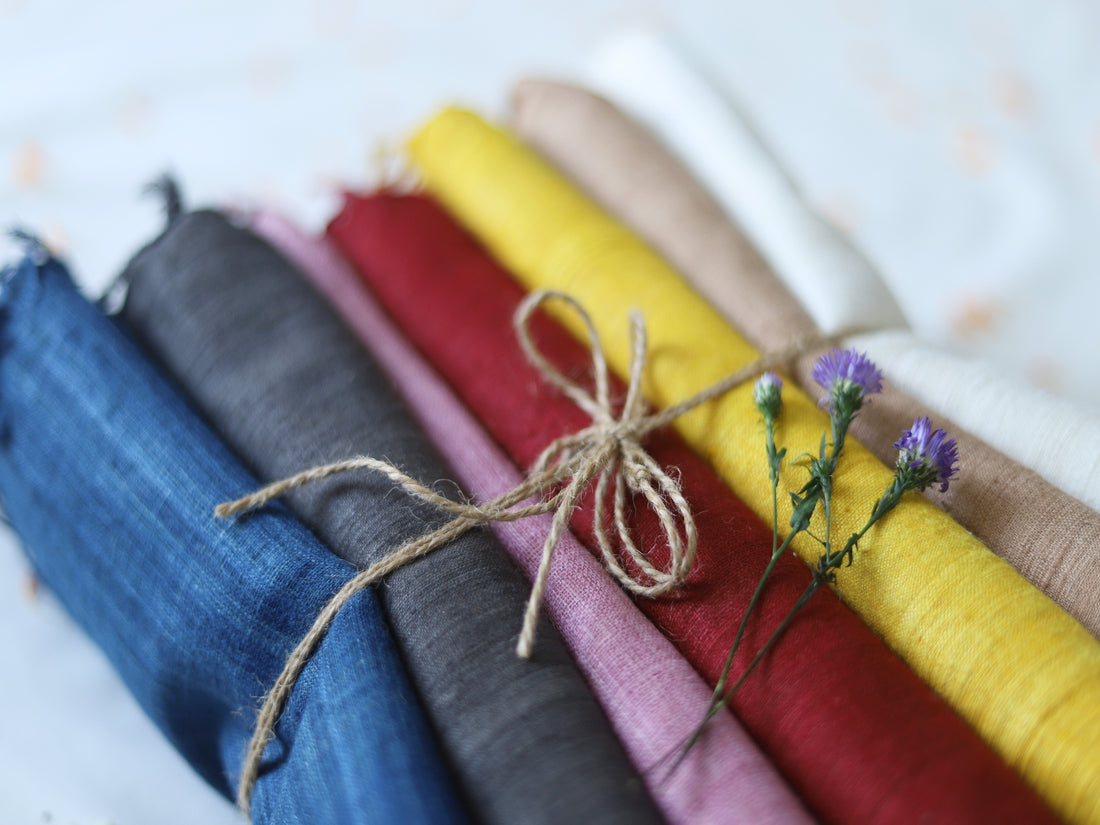
How Arras Creates Ahimsa Silk Using Hand-spun, Natural-Dyed Yarn: A Step-by-Step Guide
Share
At Arras, we are dedicated to creating sustainable and ethical fashion that supports local communities and preserves traditional craftsmanship. Our Ahimsa silk is produced in partnership with artisans from rural villages in Assam in Northeast India, where we work closely with skilled weavers, spinners, and dyers who practice age-old methods passed down through generations. By providing fair wages and sustainable employment, we empower these artisans to continue their craft while promoting eco-friendly and ethical fashion practices. Our Ahimsa silk creations, made using hand-spun, natural-dyed yarn, reflects this commitment to quality and conscious fashion. Here's how we create this beautiful fabric for our sarees, stoles and garments:
Step 1: Harvesting Silk Cocoons
- Sustainable Silkworm Rearing: The silkworms are reared by feeding them the leaves of castor and tapioca plants, which are grown in the wild without the use of pesticides or fertilisers. This method of feeding ensures that the silkworms receive a natural and healthy diet while maintaining an eco-friendly approach to silk production. The plants are locally sourced and cared for by farmers in the villages, contributing to sustainable agricultural practices and providing an additional source of income for rural communities. 1 little silkworm can eat up to 7-8 kilograms of leaves!

- Natural Lifecycle of Silkworms: In Ahimsa silk production, silkworms eggs are purchased from government sericulture farms are allowed to hatch from their cocoons naturally. Seed to worm takes up to 25 days in the humid Assamese summer and upto 45 days in the winter. Once they are well fed, the worms start spinning the cocoons around themselves. The cocoons are collected only after the silkworms have emerged as moths, completing their life cycle.
- Collection of Cocoons: After the moths break out, the empty cocoons are collected for further processing. The leftover silk fibres are typically shorter and less continuous, but they can be spun into yarn.

Step 2: Degumming the Silk
- Degumming Process: The cocoons are soaked in warm water with natural soap to remove the sericin, a sticky protein that binds the silk fibres. This process softens the fibres, making them easier to spin.
- Drying the Cocoons: The boiled cocoons are flattened into round discs and pressed onto the mud walls of the spinner's home. The flattened cocoons are then left to air dry.
- Manual Handling: Unlike industrial processes, which use harsh chemicals, Ahimsa silk producers often rely on natural soaps and gentle agitation to preserve the fibres' integrity and quality.
- Hand-spinning the Silk: After they are dry, the silk fibres are carded and combed to remove any impurities and align the fibres. Then, the fibres are hand-spun into yarn using a spinning wheel (charkha) or spindle.
- Creating Hand-spun Yarn: The spinner carefully twists the fibres together to create a continuous thread, producing a yarn that retains the natural texture and sheen of the silk.

- Sourcing Natural Ingredients: Natural dyes are made from various plant materials, such as indigo leaves, turmeric roots, madder, onions skins, and other botanical sources. These materials are collected, cleaned, and prepared for dye extraction.
- Extraction of Dyes: The plant materials are boiled in water to extract their natural pigments. This liquid is then filtered to remove any plant debris, resulting in a concentrated dye solution.

Step 5: Dyeing the Yarn
- Pre-Mordanting the Yarn: Before dyeing, the hand-spun yarn is treated with a mordant (a substance that helps the dye bond to the fibres). Common natural mordants include alum, iron, or tannin-rich plants.
- Immersion in Dye Baths: The yarn is then immersed in the dye baths, where it is soaked for a specific time to achieve the desired colour. The process may be repeated several times for richer hues. After dyeing, the yarn is rinsed thoroughly and hung to dry in the shade to preserve its colour.
- Handloom Weaving: The naturally dyed, hand-spun yarn is then woven into fabric using traditional handlooms. This manual process allows for greater control over the texture and pattern, creating a unique, artisanal quality in each piece of silk fabric.
- Creating the Ahimsa Silk Fabric: Weavers use traditional techniques to create various textures and patterns, often incorporating motifs and designs that reflect Assamese cultural heritage. The slow, deliberate process of handloom weaving ensures that each piece of Ahimsa silk is a one-of-a-kind creation.

Step 7: Finishing the Fabric
- Washing and Finishing: After weaving, the fabric is washed gently to remove any excess dye and impurities. It is then stretched and dried naturally, often under shade, to prevent any fading or damage to the fibres.
- Final Touches: The fabric is inspected for quality and any minor adjustments or repairs are made by hand to ensure the fabric meets the desired standards.
Also known as Peace silk, and Eri in Assamese, the production of Ahimsa silk is a labour-intensive process that has been made by preserving traditional techniques while respecting the environment and animal life. The hand-spun and naturally dyed yarn used in Ahimsa silk production results in a fabric that is not only eco-friendly but also unique in texture and appearance, with a natural sheen and softness. Additionally, its production supports traditional artisans and rural communities, providing sustainable livelihoods while preserving cultural heritage and promoting environmentally responsible practices. Ahimsa silk is breathable, lightweight, and suitable for all seasons, making it an excellent choice for sustainable fashion lovers.
